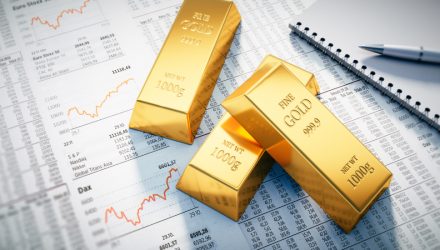As we look to the underlying fundamentals of gold, investors can consider exchange traded funds to gain exposure to the asset and access the counter-correlated movements in the yellow metal.
In the recent webcast, Hedge or Diversifier? The Modern Take on Gold, George Milling–Stanley, Chief Gold Strategist, State Street Global Advisors, and Juan Carlos Artigas, Director, Investment Research, World Gold Council, will review investment allocations to gold as a way to help mitigate volatility in times of crisis. In the first half of the year, Gold has helped hedge against the uncertainty during the pandemic and growing concerns about inflation, and it was one of the best-performing assets of 2020.
Gold-backed ETFs attracted large inflows over the first quarter. The large inflows came at the expense of a sharp decline in gold jewelry demand over the first three months of the year. Central banks continued to buy gold, albeit at a slower pace. Additionally, gains in a developed market bar and coin demand helped offset weakness in Asia.
The strategists highlighted four key trends in the 2020 outlook. First off, financial and geopolitical uncertainty combined with low interest rates may continue supporting gold investment demand. Secondly, net gold purchases by central banks may remain robust even if they are lower than the record highs seen in recent quarters. Momentum and speculative positioning may keep gold price volatility high. Lastly, gold price volatility and expectations of weaker economic growth may result in softer consumer demand near-term.
As more central banks cut back on interest rates and even implement negative rates to help stimulate growth, gold could continue to shine. Gold returns during periods of negative real rates have been double their historical averages. The precious metal has also exhibited a high correlation to the increase in the amount of global negative-yielding debt.
If inflation is to spike as a direct result of these aggressive loose monetary policies, gold can also benefit as a way to help investors safeguard their purchasing power. Looking at average annualized returns during various inflationary periods, gold showed an annualized return of 8.4% when inflation was below 2% and an annualized return of 16.2% when inflation was above 5%.
Monetary policy and interest rates are only part of the overall picture. For example, periods of growth historically have been supportive of jewelry, which accounts for around 50% of yearly demand. Market downturns historically have boosted the price of gold. The price of competing assets such as bonds, currencies, and other assets, may influence investor attitudes towards gold. Additionally, capital flows, positioning, and price trends may support or dampen gold’s performance.
In the current market environment, the coronavirus or COVID-19 pandemic has also affected the global gold supply chain from areas like mining, processing, refining, recycling, and delivery. The disruption has also caused COMEX gold futures positioning to uncouple from gold’s recent performance due to increased costs associated with the disruptions. In early April, the differential between gold futures and spot prices substantially increased.
Consequently, more are turning to the easy-to-use and cheap gold ETFs as a more efficient tool to access the gold markets. Specifically, something like the SPDR Gold Shares (NYSEArca: GLD), the most liquid and largest physically backed gold-related ETF on the market, has been the go-to ETF option for gold investments. The SPDR Gold MiniShares Trust (NYSEArca: GLDM) is also a low-cost gold ETF that has quickly attracted attention from buy-and-hold investors who are interested in the long-term benefits of incorporating a cheap gold investment in a diversified portfolio.
For more market trends, visit ETF Trends.
